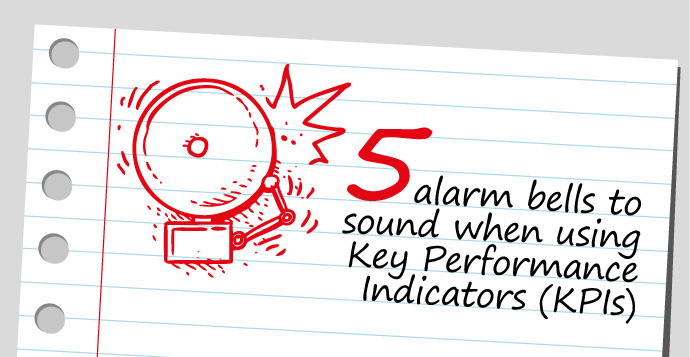In my many years of experience consulting for public and private sector clients, effective performance measures or Key Performance Indicators (KPIs) were always a core component of any good strategy development project. This follows from the adage “You can only manage what you can measure”.
While their role is essential, KPIs that matter most can be somewhat puzzling in their selection and use. This can get especially confusing when you have books in the market touting titles such as “17 thousand KPIs” and “the 75 most important KPIs”. Even the most seasoned managers find difficulty in drawing a balance between measuring enough things without going overboard.
When selected properly, KPIs can help managers ensure their strategic objectives and initiatives are progressing in the right direction and decisions are made according to the right metrics. In their basic form, KPIs should have a clear unit of measure and formula. Moreover, KPIs should have clearly defined owners and proper documentation to support their use. Owners should be individuals who know everything about their KPIs’ anatomies can celebrate their successes and can be held accountable for their failures. However, experience has taught us that there are five alarm bells that you need to sound if you ever hear any of the following statements related to KPIs:
Alarm bell 1: “Data Source? What data source?”
In order to make decisions that help the organization achieve its objectives and initiatives, the data sources that feed KPI results need to be reliable. Imagine a health ministry interested in tackling the most fatal diseases in its jurisdiction. Without reliable data sources documenting these diseases, their prevalence, causes and trends, it would be impossible for the ministry to achieve KPI targets such as lower mortality rates from such diseases. For this scenario, good practices in government have called for the creation of national statistics centers to ensure that KPI results have clear data providers with dedicated quality officers. The statistics center in this case would work hand in hand with the health ministry to train healthcare professionals in all sectors on best practices related to the collection and reporting of data related to such diseases. Data would be collected from all healthcare establishments by the statistics center at all society levels and fed back to the health ministry for analysis and corrective action. Trained professionals at the statistics center can provide the health ministry with the reliable data that they need.
Alarm bell 2: “Happy to give you these survey results, just give me a couple of months and more money!”
If the KPI results are not available on-demand or within acceptable time limits that allow for swift decision making, then the results will be obsolete. For instance, some organizations continue to spend thousands of dollars on customer satisfaction surveys that require months to design, roll-out, analyze and report. By the time the data can be used, the customers would have already moved on. These days, the availability of technology and new ways of customer interaction allow organizations to have almost instant feedback on the level of service. I visited a GCC airport recently where they used an electronic tablet to capture customer feedback with a single customer satisfaction question. The tablet was placed in a visible location following the exit from the customs area. Customers were expected to rate the service using the provided tablet which was clearly displayed. This is an example of a timely and cost-effective way to gather feedback right at the point of service.
Alarm bell 3: “Do not blame us for our behavior, blame the KPI!”
The wrong KPI can drive the wrong behavior by the KPI owner. I was once told a story about traffic officers that were given a KPI of number of traffic violations issued per month. If they issue their target number of violations, they were rewarded for their services; otherwise, they would be in trouble! The officers were in turn incentivized to issue violations at any cost, especially towards the end of the month. The initial objective behind the KPI was well-intentioned but the outcome was negative. Instead of relying only on a single KPI that may be biased, a second KPI that focuses on the officers’ awareness role to the public can be added. For instance, this second KPI can measure the officers’ success in educating the public on safe driving practices.
Alarm bell 4: “Let’s plan for a 3-hour meeting so I can explain this KPI to you”
KPIs, especially strategic ones, are intended in part to communicate how an organization is measuring its performance. If this communication tool is complex or broken, it will have a negative effect. Unfortunately, some KPIs are written in such a way that only a handful of people understand their meaning. Remember that KPIs will require time and money to measure and the more complex they are, the more effort they will require in calculation and explanation. Also, using standard industry or functional KPIs will allow the manager to benchmark effectively the KPI target against competitors or industry standards. Finally, no matter what the technical nature of the KPI, the KPI owner should remember that the typical recipient of KPI reports are non-technical senior managers who want to relate the performance results to business decisions. For instance, measuring nationalization in an organization can be as simple as using a KPI such as “% of managerial positions filled by nationals”. Trying to use a sophisticated KPI such as “% of managerial positions filled by nationals who are recruited from local universities with technical backgrounds and who have been with the company for less than 3 years” does not really provide the insights it is intended to in the first place.
Alarm bell 5: “How can our KPI results say we are doing well, while in fact things are in terrible shape?”
Be careful not to dumb down the data. For instance, using averages for KPIs is a powerful way to summarize a number of supporting KPIs, but showing them out of context or as absolute figures can present a misleading picture of reality. For instance, a restaurant chain may decide that an average customer satisfaction score of 85% across its 10 branches is considered high compared to competitors. This conclusion, however, may not provide the full picture. By drilling down to a deeper level, the manager in charge may find that a small but crucial number of locations are underperforming. For instance, two of them had customer satisfaction scores of less than 50%. This wasn’t evident as their scores were hidden in the roll up of the KPI that was shown which is the “average customer satisfaction score across locations”. The only way to find out is to provide the option of drilling down the KPI to lower levels.
In conclusion, I continue to believe that the use of KPIs is more art than science. There will always be KPIs that we use for the first time that need review and sometimes complete elimination based on response from the field. Great organizations have feedback loops in place to allow for such educated and swift action to correct course. I am however confident that even though the alarm bells presented earlier have been problematic for others, they should now be harmless to you. As Sam Levenson, the famous humorist once said: “You must learn from the mistakes of others. You can’t possibly live long enough to make them all yourself”.





